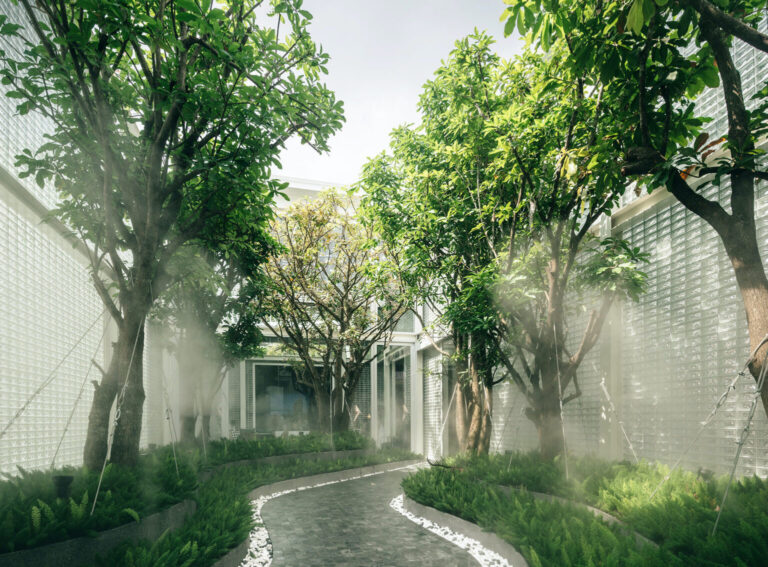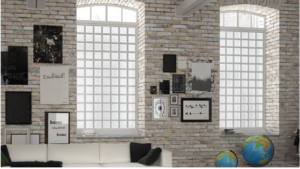The terms “glass brick” and “glass block” are often used interchangeably. If you’ve ever made a search for glass brick on the Internet, you’ll discover that glass brick is usually subsumed under what is thought of as the umbrella term: glass block. This leads to an awful lot of confusion. Actually, glass brick and glass block are distinctly different glass building materials: they have different characteristics and properties and therefore different applications. In this article we’ll take a deep dive into everything glass brick to clarify any confusion.
Glass Brick is Solid
Well, there you have it, the main difference. Glass brick is solid whereas glass block is hollow. Glass brick is made by pouring liquid glass into steel molds, which are then cooled slowly under controlled conditions to ensure the glass does not crack.
Because glass brick is solid, it presents less optical distortion than glass block. It also has a higher compression strength, usually over 200 MPa (approximately 30,000 psi). However, while they can support themselves to a degree, they are not load bearing and would not be able to support the wall above.
There are a couple of drawbacks to a solid glass brick, namely it is heavier and, as well, provides less thermal insulation than a hollow glass block. Glass brick is also more expensive.
How Glass Brick is Used
The unique optical qualities of glass brick allows for versatility in how it is used. Here at Quality Glass Block, we carry two lines of glass brick: our performance line called Vistabrik ®, and Vetropieno®, under our Solid Glass Bricks category.
Vistabrik® Glass Brick
Vistabrik®, our performance glass brick, is made to resist bullets, impacts, fire, graffiti and noise, and is often employed in areas with high levels of vandalism, noise and other security issues.
Although it is 3 inches thick, clear Vistabrik still offers 90% light transmittance with low distortion, while the stippled pattern provides 83% light transmission, making either one ideal for situations that require both visibility/supervision and security. The stippled pattern provides more privacy while still allowing light to pass though. Daylighting also increases well-being for the occupants of a building.
Vistabrik® is perfect for interior or exterior use, is durable and does not require much maintenance. Because of all these qualities, Vistabrik® is often used in institutional, commercial or public spaces where security is a must and beautiful aesthetics just makes everything better.
Vetropieno® Glass Brick
Vetropieno® glass brick highlights the scintillating, sophisticated qualities of the material, bringing a unique beauty to a space. Because these bricks are solid, light flows differently through the glass, imparting a depth of color and mysterious elegance to any interior or exterior structure.
The original Vetropieno® comes in two sizes (rectangular and square), and four colors: Blue, Siena, Nordica, and Neutro. The Americano Vetropieno®, which is smaller than the original Vetropieno® to emulate the size of a masonry brick, comes in a rectangular and a square shape and is a clear, Neutro color.
Vetropieno® glass brick are perfect for anywhere you’d like to add some luxury and polish: bathrooms, kitchens, accent walls, divider walls, accent pieces such as kitchen islands or bars, interior or exterior pool areas, commercial building facades and on and on.
Structural Systems For Glass Brick
There are a variety of structural systems used for the installation of glass brick, depending on the load as well as the look you are trying to achieve. Glass brick can be installed using mortar, which is very strong and imparts a visually traditional appearance, or it can employ more recent, innovative structural systems to create seamless, transparent walls that are absolutely stunning.
The three basic types of structural systems are:
- Metal substructure
- Mortar, silicone or other adhesively bonded bricks
- Interlocking glass brick or installation systems
Metal Substructure
A metal substructure can be used to provide rigidity and prevent buckling in a glass brick facade. For example, the Optical House in Hiroshima Japan (2013), uses glass brick threaded with metal rods suspended from a steel beam above to align the rows of bricks and provide lateral stability. The glass brick is able to carry its own weight. No mortar was used. However, while discreet and stunning, described as being like a visual waterfall, the metal substructure is still visible.
Mortar, Silicone or Other Adhesively Bonded Glass Brick
While glass brick can be installed using an opaque mortar, transparent silicone or other adhesives can be used to create a wall that is not broken up by a visible grid. The best known example of an adhesively bonded glass brick façade is the Crystal Houses upscale storefront in Amsterdam. The use of a specially engineered transparent adhesive allows for a completely transparent wall that playfully maintains the character of the historical architecture, while still allowing the transparent window surface that modern stores require.
Interlocking Glass Brick or Installation Systems
An interlocking glass brick is promising, but is still in the research stage. With an interlocking glass brick, stability would be obtained vertically from the weight of the glass brick, while lateral movement would be restrained by the interlocking geometry. The resulting construction would be completely transparent, and the material could be disassembled and reused since no adhesive is needed, making it more environmentally friendly. The closest we have to this ideal currently are interlocking installation systems such as the VetroKWIK™ system for Vetropieno® solid glass brick. It snaps together and does away with the need for mortar or silicone.
Use Glass Brick in Your Next Project
If you’re inspired to use glass brick in your next project, give us a call. Our experts can provide tips and guide you on what exactly you need for the project you envision.





Give us a follow!